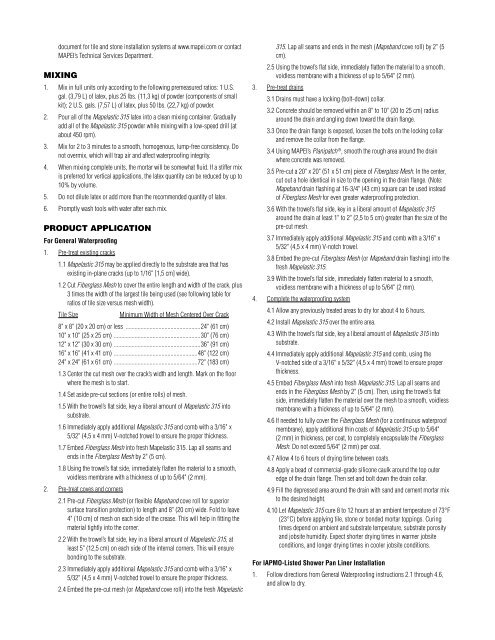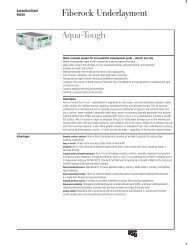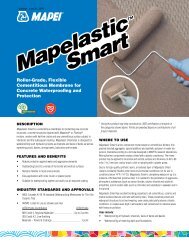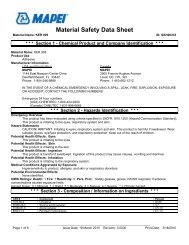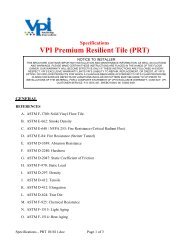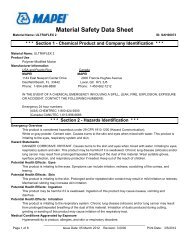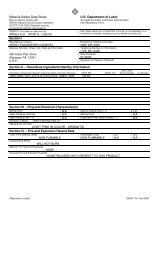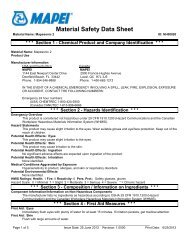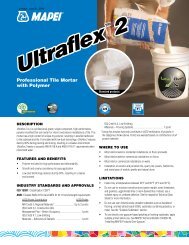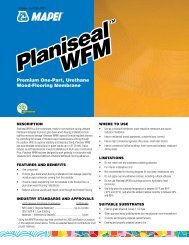Mapelastic 315 Mapelastic 315 - BuildSite.com
Mapelastic 315 Mapelastic 315 - BuildSite.com
Mapelastic 315 Mapelastic 315 - BuildSite.com
- No tags were found...
You also want an ePaper? Increase the reach of your titles
YUMPU automatically turns print PDFs into web optimized ePapers that Google loves.
document for tile and stone installation systems at www.mapei.<strong>com</strong> or contactMAPEI’s Technical Services Department.MIXING1. Mix in full units only according to the following premeasured ratios: 1 U.S.gal. (3,79 L) of latex, plus 25 lbs. (11,3 kg) of powder (<strong>com</strong>ponents of smallkit); 2 U.S. gals. (7,57 L) of latex, plus 50 lbs. (22,7 kg) of powder.2. Pour all of the <strong>Mapelastic</strong> <strong>315</strong> latex into a clean mixing container. Graduallyadd all of the <strong>Mapelastic</strong> <strong>315</strong> powder while mixing with a low-speed drill (atabout 450 rpm).3. Mix for 2 to 3 minutes to a smooth, homogenous, lump-free consistency. Donot overmix, which will trap air and affect waterproofing integrity.4. When mixing <strong>com</strong>plete units, the mortar will be somewhat fluid. If a stiffer mixis preferred for vertical applications, the latex quantity can be reduced by up to10% by volume.5. Do not dilute latex or add more than the re<strong>com</strong>mended quantity of latex.6. Promptly wash tools with water after each mix.PRODUCT APPLICATIONFor General Waterproofing1. Pre-treat existing cracks1.1 <strong>Mapelastic</strong> <strong>315</strong> may be applied directly to the substrate area that hasexisting in-plane cracks (up to 1/16" [1,5 cm] wide).1.2 Cut Fiberglass Mesh to cover the entire length and width of the crack, plus3 times the width of the largest tile being used (see following table forratios of tile size versus mesh width).Tile SizeMinimum Width of Mesh Centered Over Crack8" x 8" (20 x 20 cm) or less ...................................................24" (61 cm)10" x 10" (25 x 25 cm) ..........................................................30" (76 cm)12" x 12" (30 x 30 cm) ..........................................................36" (91 cm)16" x 16" (41 x 41 cm) ........................................................48" (122 cm)24" x 24" (61 x 61 cm) ........................................................72" (183 cm)1.3 Center the cut mesh over the crack’s width and length. Mark on the floorwhere the mesh is to start.1.4 Set aside pre-cut sections (or entire rolls) of mesh.1.5 With the trowel’s flat side, key a liberal amount of <strong>Mapelastic</strong> <strong>315</strong> intosubstrate.1.6 Immediately apply additional <strong>Mapelastic</strong> <strong>315</strong> and <strong>com</strong>b with a 3/16" x5/32" (4,5 x 4 mm) V-notched trowel to ensure the proper thickness.1.7 Embed Fiberglass Mesh into fresh <strong>Mapelastic</strong> <strong>315</strong>. Lap all seams andends in the Fiberglass Mesh by 2" (5 cm).1.8 Using the trowel’s flat side, immediately flatten the material to a smooth,voidless membrane with a thickness of up to 5/64" (2 mm).2. Pre-treat coves and corners2.1 Pre-cut Fiberglass Mesh (or flexible Mapeband cove roll for superiorsurface transition protection) to length and 8" (20 cm) wide. Fold to leave4" (10 cm) of mesh on each side of the crease. This will help in fitting thematerial tightly into the corner.2.2 With the trowel’s flat side, key in a liberal amount of <strong>Mapelastic</strong> <strong>315</strong>, atleast 5" (12,5 cm) on each side of the internal corners. This will ensurebonding to the substrate.2.3 Immediately apply additional <strong>Mapelastic</strong> <strong>315</strong> and <strong>com</strong>b with a 3/16" x5/32" (4,5 x 4 mm) V-notched trowel to ensure the proper thickness.2.4 Embed the pre-cut mesh (or Mapeband cove roll) into the fresh <strong>Mapelastic</strong><strong>315</strong>. Lap all seams and ends in the mesh (Mapeband cove roll) by 2" (5cm).2.5 Using the trowel’s flat side, immediately flatten the material to a smooth,voidless membrane with a thickness of up to 5/64" (2 mm).3. Pre-treat drains3.1 Drains must have a locking (bolt-down) collar.3.2 Concrete should be removed within an 8" to 10" (20 to 25 cm) radiusaround the drain and angling down toward the drain flange.3.3 Once the drain flange is exposed, loosen the bolts on the locking collarand remove the collar from the flange.3.4 Using MAPEI’s Planipatch ® , smooth the rough area around the drainwhere concrete was removed.3.5 Pre-cut a 20" x 20" (51 x 51 cm) piece of Fiberglass Mesh. In the center,cut out a hole identical in size to the opening in the drain flange. (Note:Mapeband drain flashing at 16-3/4" (43 cm) square can be used insteadof Fiberglass Mesh for even greater waterproofing protection.3.6 With the trowel’s flat side, key in a liberal amount of <strong>Mapelastic</strong> <strong>315</strong>around the drain at least 1" to 2" (2,5 to 5 cm) greater than the size of thepre-cut mesh.3.7 Immediately apply additional <strong>Mapelastic</strong> <strong>315</strong> and <strong>com</strong>b with a 3/16" x5/32" (4,5 x 4 mm) V-notch trowel.3.8 Embed the pre-cut Fiberglass Mesh (or Mapeband drain flashing) into thefresh <strong>Mapelastic</strong> <strong>315</strong>.3.9 With the trowel’s flat side, immediately flatten material to a smooth,voidless membrane with a thickness of up to 5/64" (2 mm).4. Complete the waterproofing system4.1 Allow any previously treated areas to dry for about 4 to 6 hours.4.2 Install <strong>Mapelastic</strong> <strong>315</strong> over the entire area.4.3 With the trowel’s flat side, key a liberal amount of <strong>Mapelastic</strong> <strong>315</strong> intosubstrate.4.4 Immediately apply additional <strong>Mapelastic</strong> <strong>315</strong> and <strong>com</strong>b, using theV-notched side of a 3/16" x 5/32" (4,5 x 4 mm) trowel to ensure properthickness.4.5 Embed Fiberglass Mesh into fresh <strong>Mapelastic</strong> <strong>315</strong>. Lap all seams andends in the Fiberglass Mesh by 2" (5 cm). Then, using the trowel’s flatside, immediately flatten the material over the mesh to a smooth, voidlessmembrane with a thickness of up to 5/64" (2 mm).4.6 If needed to fully cover the Fiberglass Mesh (for a continuous waterproofmembrane), apply additional thin coats of <strong>Mapelastic</strong> <strong>315</strong> up to 5/64"(2 mm) in thickness, per coat, to <strong>com</strong>pletely encapsulate the FiberglassMesh. Do not exceed 5/64" (2 mm) per coat.4.7 Allow 4 to 6 hours of drying time between coats.4.8 Apply a bead of <strong>com</strong>mercial-grade silicone caulk around the top outeredge of the drain flange. Then set and bolt down the drain collar.4.9 Fill the depressed area around the drain with sand and cement mortar mixto the desired height.4.10 Let <strong>Mapelastic</strong> <strong>315</strong> cure 8 to 12 hours at an ambient temperature of 73°F(23°C) before applying tile, stone or bonded mortar toppings. Curingtimes depend on ambient and substrate temperature, substrate porosityand jobsite humidity. Expect shorter drying times in warmer jobsiteconditions, and longer drying times in cooler jobsite conditions.For IAPMO-Listed Shower Pan Liner Installation1. Follow directions from General Waterproofing instructions 2.1 through 4.6,and allow to dry.


